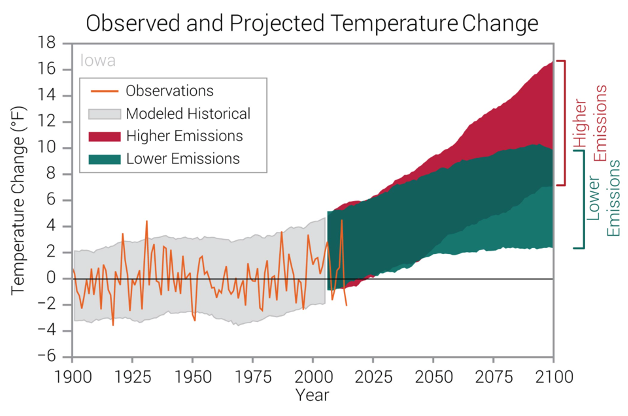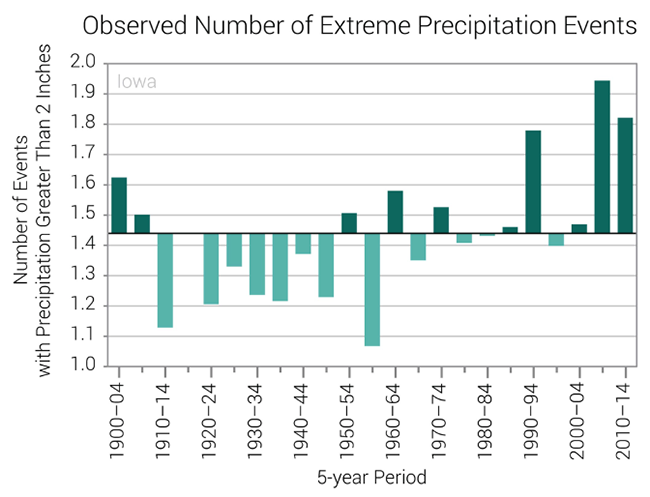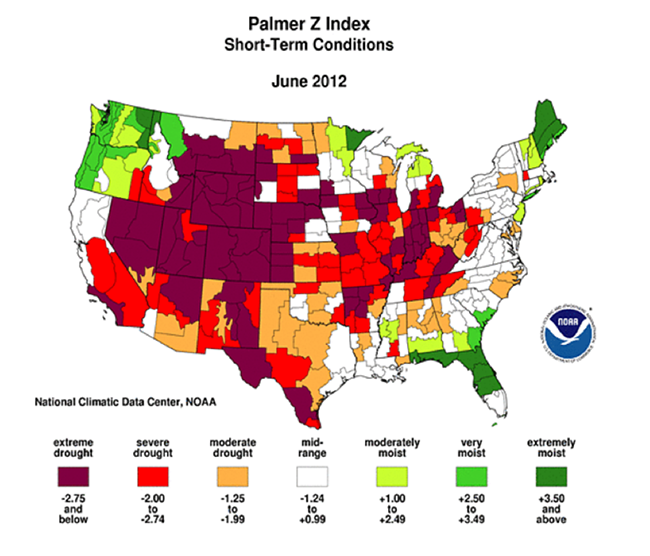
REPOWER AMERICA®: How the Climate Crisis is Affecting Iowa

Like so many other Midwestern US states, Iowa is already feeling the effects of the climate crisis. Across the state, communities are seeing higher temperatures, more extreme weather, and changes to cherished natural wonders. And these effects will only become more pronounced unless we act boldly to slash greenhouse gas emissions.
Wondering exactly how the climate crisis is affecting the state? Read on to get the facts.
Rising Temperatures
Here’s the climate reality: average annual temperatures in Iowa have increased about 1-degree Fahrenheit over the last two decades. Without action to address the climate crisis, “historically unprecedented warming” is expected by the end of this century.
According to the Union of Concerned Scientists, “across the Midwest, signs of our rapidly changing climate become clearer each year. Records show that spring is arriving sooner, dangerously hot weather is occurring more often, and winters are becoming warmer and less snowy.”
This is particularly true in Iowa.

In 2012, Iowans experienced their warmest year ever, with average temperatures almost 4.6 degrees Fahrenheit above normal. And if humans don’t drastically curb our use of fossil fuels, by the end of the twenty-first century, the state will see continued warmer winters and rising nighttime temperatures.
Without action, by 2100, Iowa could see around 55 days per year with a heat index above 100 degrees Fahrenheit. And 30 of those could have a heat index of 105 degrees Fahrenheit or more.
Currently, Iowa averages fewer than five dangerous heat days a year.
Rising temperatures like this have big consequences, but perhaps none is more important than the impact on human health. That’s because very high heat is extremely dangerous for the human body, especially when it’s combined with spikes in humidity. More than 70,000 Iowans are considered especially vulnerable to extreme heat.
Heavy Precipitation and Flooding
Here’s the climate reality: Flooding in Iowa has occurred periodically in recent years with major impacts in several communities across the state. Future increases in extreme precipitation events may increase the intensity and frequency of floods.
In March, May, and September 2019, Western Iowa experienced “catastrophic” flooding.
As reported in the Des Moines Register, “the flood in mid-March was the result of rapid snowmelt mixed with heavy rainfall upstream…[And] In September, the Missouri River basin north of Sioux City experienced 200 percent more precipitation than normal, according to the Army Corps of Engineers.”
Events like this are expected to become more common in the state as our climate continues to change. As temperatures become warmer and warmer, more water from the planet’s oceans, lakes, rivers, and land evaporates. This, in turn, means more intense storms with heavier precipitation when all of that evaporated water falls back to the earth’s surface.
Researchers at the Iowa State University, Institute for Transportation found that “for the Cedar River Basin in Iowa, the 100-year flood ... of the 20th century is projected to be a 25-year flood in the 21st century, with associated increased frequency of flooding of agricultural land.”

With many waterways located alongside cities and farmland, flooding is a major threat to commerce in the state.
Iowa is experiencing bigger and bigger floods because it is seeing more and more rain.
University of Wisconsin-Eau Claire professor James Boulter reported that “Iowa and the Upper Midwest have a much clearer trend in annual precipitation than the whole of the contiguous US. … This region’s average annual rainfall has been steadily rising at almost one inch per decade — a total increase of over 12 percent since the mid-1970s. Iowa’s statewide trend over the same period is still higher at 1.25 inches per decade – the largest increase across the US.”
Drought
Here’s the climate reality: Drought in Iowa has occurred periodically in recent years with major impacts in several communities across the state. Future increases in extreme evaporation rates may increase the intensity and frequency of droughts.
Here’s a head scratcher: Precipitation is expected to increase across Iowa and the Midwest region over the next few decades, especially in the winter and spring. So how is it possible that the state is expected to see more extreme drought? Think about it this way: While the state may not see more droughts overall, when droughts do strike, they are likely to pack a stronger and stronger punch.
That’s because climate change makes our water cycle more intense – in both directions. Higher temperatures mean more water is evaporating from land into the atmosphere. This means less moisture in the soil, and when you couple that with earlier and earlier snowmelt from rising average temperatures, land can dry out – so even when it does rain, the precipitation sometimes runs off the hard, dried-out soil, contributing to a sort of feedback loop that can make the drought even worse.

The year 2012, for example, offered a glimpse of what drought might look like in Iowa (and other parts of the agriculturally important US Midwest region) in the future without aggressive climate action. That September, much of the state was listed as being in “extreme” drought, with areas in the northwest experiencing “exceptional” drought conditions lasting into 2013.
The low July and August rainfall totals that Iowa experienced in 2011, 2012, and 2013 were unlike any seen in the state dating back to 1893… including during the Dust Bowl.
And then just a few years later, as discussed in the section above, the state was contending with historic floods. That’s climate change in a nutshell – it makes weather events of all kinds more and more extreme.
You Can Take Action, Wherever You Live
To change everything, we need everyone.
Are you ready to learn even more about how we can move together to end the climate crisis?
Sign up now to receive emails from Climate Reality with the latest climate science and news on this crisis, as well as ways you can get involved with the movement for solutions.

